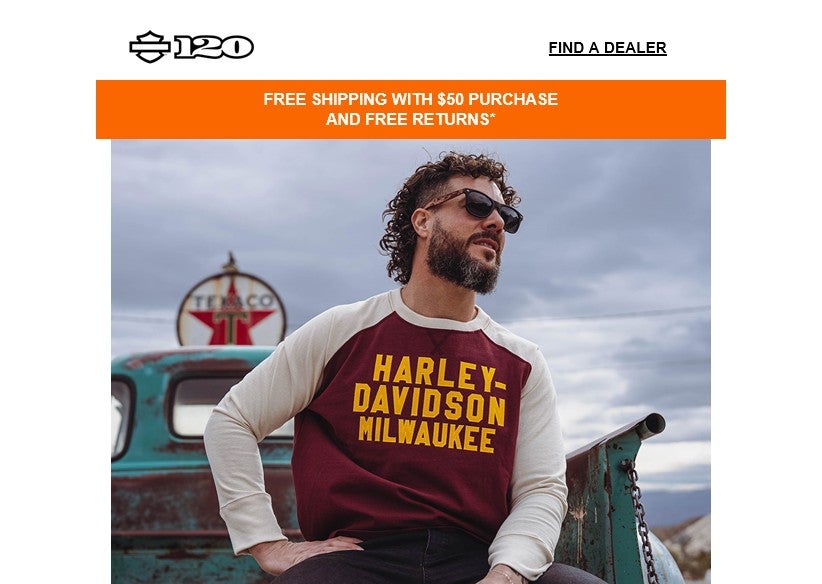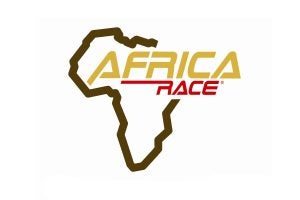Sometimes, it’s strange how things hit you. I was sitting at my keyboard when a Harley-Davidson email pinged my inbox. Curious about what the MoCo was up to, I opened it to find that the message was about Harley-Davidson branded parts, garments, and accessories (PG&A). While a marketing email about a manufacturer’s branded accessories is not at all unusual, it did start me thinking about the emails they were sending and what they were about.
Considering the changes that Harley-Davidson is going through under the leadership of its CEO, Jochen Zeitz, I began to wonder precisely how many emails the MoCo had sent and the message inside each of them. Were they about the machines themselves, financing, or Harley lifestyle things like PG&A and events?
As a result, I had started down a rabbit hole that would be deeper and potentially darker than I originally envisioned. What was Harley trying to reach me about? Did their marketing emails seem to emphasize one product line over another? When and how many times did the MoCo reach out to me?
Down the rabbit hole
And like Alice falling down the rabbit hole in “Alice In Wonderland,” it took a fair amount of time to reach the bottom. In fact, my journey took several hours. When I had finished reviewing what Harley had been sending since the beginning of the year (2023), I had read through 46 emails. The sheer volume of them only made me ponder more about what the MoCo may be trying to tell me, the Harley faithful and the non-riding “dreamers” that Jochen Zeitz has said he wants to attract to the Bar and Shield.
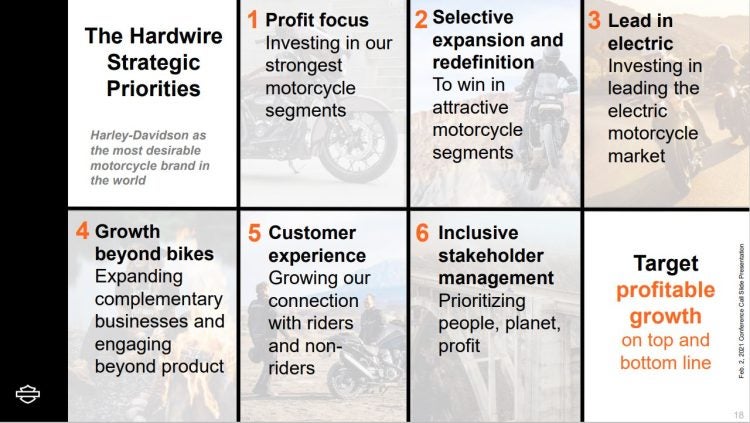
A Harley-Davidson investor slide identifying the pillars of the MoCo’s business strategy. Items 4 and 5 seem to be taking a prominent role. Image: Harley-Davidson
As I scrolled through all the Harley-Davidson emails, it was clear that they were trying to cover a lot of ground in a single email. Rarely did the email address only a single topic. Most of the time, several different products were bundled into the message. And when I say products, I don’t mean several different types of a single product. I mean that the emails mentioned garments, moto gear, accessories, H-D paraphernalia, events, etc., all in one email. You get the idea.
Surveying Harley’s emails
It quickly became clear that if I wanted to get an accurate picture of what the MoCo was trying to tell me, it would take some doing. So I decided to build a very rudimentary, and I emphasize a very unscientific way to look at the things that Harley’s marketing department wanted me to know about.

My spreadsheet totals each mention of seven different categories in Harley’s emails. Image: Mike Botan
Over the course of a couple of hours, I built a spreadsheet with several different categories labeled motorcycle, garments, parts/moto accessories, paraphernalia, events, racing, and “other.” Each time an email mentioned one of those categories, it received a checkmark for that category such that a single email could potentially have up to seven checkmarks.
Surprising results
And when I was done, the results were somewhat surprising, to me at least. As one of the world’s most well-known motorcycle manufacturers, and the largest by a wide margin in the US, of the 46 emails Harley sent, only 10 mentioned their motorcycles (i.e., actual Harley-Davidson-produced motorcycles). Even more surprisingly, of the seven categories, the motorcycle category was the second least mentioned of all the categories. Why would a motorcycle manufacturer send communications for its motorcycles so few times? Interestingly, only one category was mentioned less, and that category was racing.
Mentioning motorcycle racing the least is not surprising since Harley axed their large-scale factory support programs for flat track racing and drag racing in 2020. Instead, they sponsor privateer racing teams in American Flat Track and the limited “King of the Bagger” series.
So why don’t Harley-Davidson’s emails promote their motorcycles more? Aren’t motorcycles the product that keeps the MoCo’s doors open? Shouldn’t they be hyping the powered two-wheelers in nearly every email they send? The answer is apparently not because their motorcycles were only mentioned in 10 of the emails I found in my inbox.
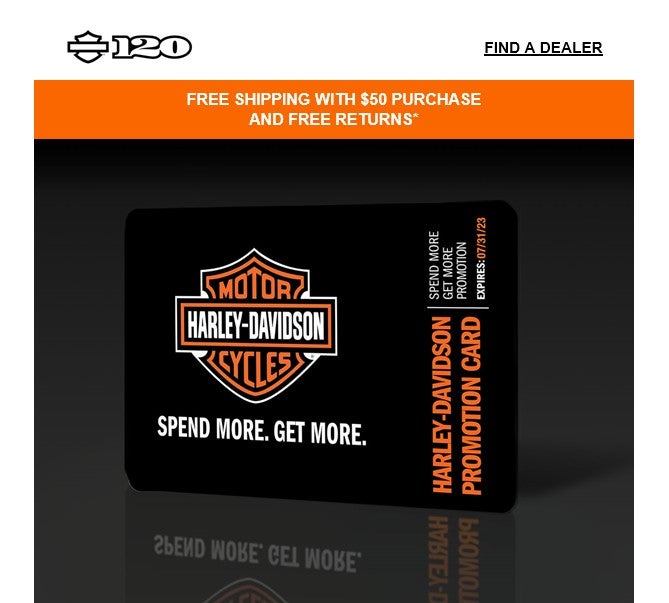
An example of the “Other” category. Image: Harley-Davidson
It’s possible, potentially probable the MoCo thinks that their machines speak for themselves and that the Harley faithful don’t need much prodding to go out and purchase their motorcycles. In fact, under Jochen Zeitz’s leadership, Harley has been producing fewer and fewer motorcycles, raising their prices, and still, people are buying the company’s machines. It appears that it is a successful formula, with Harley’s profits rising year over year.
Concentration on Parts, Garments, And Accessories (PG&A)
In an interview with the investment firm Morgan Stanley, Jochen Zeitz said that he thought garments were “way underleveraged.” He believes that garments alone should constitute a billion dollars in revenue each year. That’s a billion with a capital “B”. Interestingly, he grouped parts and accessories together, saying that they should also generate a billion dollars in yearly revenue. So, by comparison, it would seem that Zeitz believes that garment revenue alone should equal the revenue contribution of both motorcycle parts and motorcycle accessories combined. In other words, garments will produce as much revenue as both of the more directly related motorcycle revenue put together.

Another lifestyle choice? Join the H-D Membership Program. Image: Harley-Davidson.
And with the above paragraph, I thought I was pretty much done with this article. But that evening, I chatted with Kim about the email marketing findings. And she looked at me and asked, is it the same for Harley’s other social media channels? It was a great question, so it was off to look at a couple more of the MoCo’s social media outlets.
Looking at Harley’s Instagram channel
Ultimately, I chose to review Harley’s Instagram and Facebook social media accounts. To keep things relatively even, I checked the first 50 of each of Harley-Davidson’s posts in each account. In fairness, I didn’t go back the entire year because of the amount of time it would take. Accordingly, my “findings” may be skewed somewhat by the timing of events, the racing seasons, the time of year, etc. But both did provide a glimpse into what Harley was trying to market to its riders, potential riders, and non-riding “dreamers.”
And the results were interesting. Parts, Garments (apparel), and Accessories played zero roles in the posts I reviewed. And when I say a zero role, I mean that not one of the 50 posts in either of the MoCo’s Facebook and Instagram accounts was pitching apparel or parts and accessories. And refreshingly (to me, at least), posts about their motorcycles were more prominent than they had been in the emails I received.

The “Other” category was the winner on Harley’s Instagram account, followed by racing and then motorcycles. Image: Mike Botan
To get down to specifics, Harley’s motorcycles were the third highest-mentioned category, interestingly superseded by the “Other” and “Racing” categories. Both those results surprised me since, as I said earlier, Harley essentially axed its factory racing program. But the timing could have played a very large role as Harley has been pimping its participation in the limited, nine-race, “King of the Bagger” series. Even more interesting was that the “Other” category I created to cover things not found in the other categories, like lifestyle videos and pitches, moto rentals, etc., was the most mentioned of all the categories.
Up next, Facebook
Things were somewhat similar on Harley’s Facebook channel. But this time around, thankfully, Harley’s motorcycles were the star of the show and had the most mentions of all the categories. Next was the “Other” category, followed by Racing.
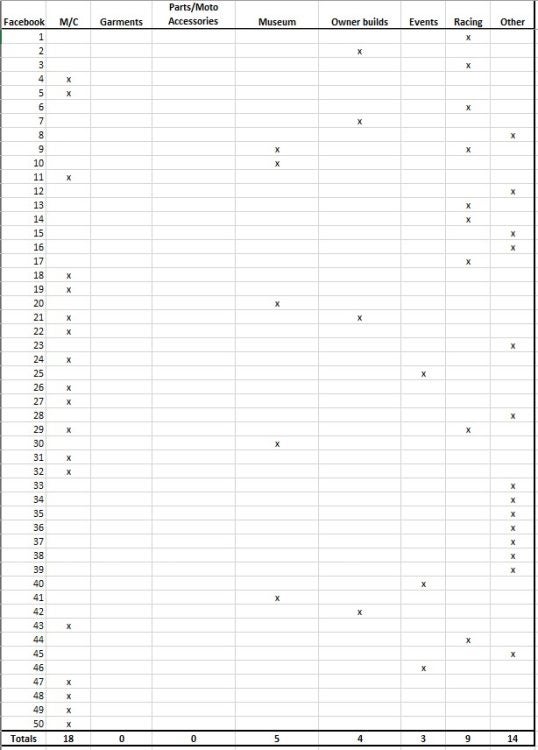
Motorcycles were the winning category on Harley’s Facebook account, followed by Other, and then racing. Image: Mike Botan
Insights
So now we have a brief peak into what Harley-Davidson thinks is important to tell its followers and dreamers. The results of this limited and unscientific analysis would suggest that Harley’s marketing priorities lie more with other categories than its motorcycles. Of the 211 posts that Harley chose to make on three of its social media channels, it mentioned its motorcycles only 41 times, or about 19 percent of the time. And as you might expect, parts, garments, and accessories garnered the most mentions at 58. Racing nearly surpassed motorcycles with 39 posts. The remainder of the 138 mentions were dispersed among all the other categories.
So what does this all mean? When all is said and done, it would appear that Jochen Zeitz is executing his “Hardwire” plan. Under the MoCo, he is producing fewer motorcycles but making more money on the fewer bikes they manufacture. Zeitz’s plan to make the Harley-Davidson brand the “most desirable” seems to be working. People are paying more money for Harley-Davidson motorcycles than they have been at any time in the past. Congrats Jochen.
So Zeitz is now free to concentrate on other areas of HD’s business, which he seems to be doing through his social media channels. He said he wanted to grow PG&A, and this survey’s results suggest that he is doing just that by limiting their posts about their motorcycles and pitching their other goods and services harder.
But is it sustainable?
I have to ask, is this plan sustainable? How long can Harley continue to increase its motorcycle prices and retain its growing profit margins? Is there some point that its riders will say, they (Harley-Davidson motorcycles) are too expensive or just plain unaffordable?
Perhaps the MoCo’s ownership of LiveWire is what they are depending on for the future. As Harley’s internal combustion engine motorcycle prices grow and gasoline-powered vehicles are legislated out of practical existence, does Harley plan to bring the LiveWire back into the company’s inner fold? And at that point, could Harley once again try to suggest that its electric motorcycles are the “most desirable” in the world?
What do you think?
What do you think about Harley-Davidson’s plans and the use of its social media? Should the MoCo’s social media channels concentrate more on their motorcycles, or is the Harley-Davidson lifestyle the most important thing for the brand? Let us know in the comments below.


